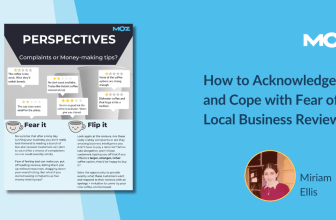How to Measure the Quality of Your SEO Traffic Using Google Analytics

[ad_1]
The author’s views are entirely his or her own (excluding the unlikely event of hypnosis) and may not always reflect the views of Moz.
Before you start reading, I’ll forewarn you that this article will start with a tweet and end with a challenge. Sound good?
From one of my favorite SEO role models, and founder of Women in Tech SEO, Areej AbuAli:
So, before getting lost in the sauce in the various metrics, it’s important you understand that your business goals are unique to you, so the way you measure your goals should reflect that. From there, the next steps are to get a better grasp of what quality traffic means for your website, and then evaluate how users engage with your content.
To get a better understanding of what’s considered “quality traffic”, we’ll look into various Google Analytics metrics that will help you create a rock solid SEO strategy.
Why does quality of traffic matter for SEO success?
At the end of the day, quality traffic is what accelerates business success, especially for post-publishing optimization.
For example, let’s assume your blog has 200 visitors per month with a conversion rate of 1%, generating two leads. By improving the quality of your traffic, your conversion rate and number of leads will also increase:
-
Traffic: 200
-
Conversion rate: 4%
-
Leads: 8
This indicates that “superfan” visitors are far more engaged and therefore more profitable than moderately excited users. Google’s new page experience algorithm update further solidifies this statement.
It’s become crystal clear that the way that consumers interact with your website contributes to your business growth.
How do you measure the quality of your organic traffic in Google Analytics?
We can go on and on about Google Analytics, but today we’re specifically looking at traffic quality. Here are the top metrics to keep an eye on:
-
Engagement metrics: time on site, pages per session, exit rate
-
Conversion metrics: conversion rate, form submissions, other goal completions,
-
Relevance metrics: bounce rate, user geo-location, new and returning visitors
Engagement Metrics
Time on site
The time on site is the measurement a user spends on a site, regardless of whether it’s being used or not. For instance, let’s say a user has multiple tabs open but isn’t necessarily using all of them at once — Google Analytics still counts the time the tabs were open.
In fact, Google counts sessions up to 30 minutes without a visitor clicking on other pages. But once the timestamp hits 30 minutes, that session will be counted as a bounce. Knowing this, it’s clear that not every user who lands on your site is highly engaged.
Generally speaking, the more time a user spends on your site the better. This indicates that your SEO strategy has defined content that is worth their while. Furthermore, the way you have structured your site not only helps them find the information they need, but they also read more about other topics or services that you might be offering.
A good time on site indicates:
To set efficient goals, you could measure time on site together with the next metric, pages per session.
Here’s a sample goal:
Users who spend an average of four minutes on your site, and at least two pages per session are more likely to be engaged with your content.
To find this metric, click audience (on the left side) > overview (underneath) > under overview, click average session duration.

Pages per session
To put it simply, pages per session is the average number of pages a user views in one session. It is one of the most important behavior metrics within GA, as it indicates how deep within your site a user navigates to. Essentially, the more pages they view, the more interested they are in what you have to say. Typically the first page a user lands on is your home page, but the goodies are on your service or product pages. With that said, to obtain quality traffic, you should aim to have at least two pages per session on average.
If you aren’t seeing these results, you need to start investigating what isn’t working. It might be that you’re targeting the wrong keywords or your audience is in the wrong country, and therefore they bounce.
If they land on your home page and don’t move onto another page, it’s a possibility that your home page isn’t properly linked to other pages, it’s too slow when loading, or the overall architecture of the site is confusing. Tweak this if necessary, and observe what happens. Often, the simpler it is to get around your site, the better!
Now, as you view your pages per session, I recommend segmenting pages per session based on channel, so you can see which streams have a greater impact and double down on that.
To find pages per session, navigate to GA, and then click “Acquisition overview”. Under the behavior bar you’ll see “pages per session”:

Exit rate
This one’s pretty straightforward. An exit rate tells you how often a customer has left your site from a page. Unlike a bounce rate (which I’ll discuss later), the exit rate tells you that a user left one page, and went to another. Let’s take a look at an example to illustrate.
Let’s say a new visitor enters your homepage, but they want to learn more, so they navigate to your blog. They spend some time reading your content and find what they want, so they exit. This shows up as a percentage under site content > all pages > exit rates.
(see image below to visually see where to find the exit rate on your Google Analytics)

Of course, if the exit rates are high you’ll want to assess elements like:
-
Website copy
-
Images/videos
-
Site load time
-
Page design
Start by tweaking one element at a time and analyze the results after each change until your exit rates start improving. Some pages will inherently have higher exit rates than others such as your privacy policy and contact us pages (usually users find what they’re looking for on Google without entering your site).
However, if you manage to decrease the exit rates for your services pages, blog posts, and/or product pages by tweaking the components we just talked about, you’ll find higher quality traffic and more conversions.
Now that you’re an expert in engagement metrics, let’s have a closer look at conversion ones.
Conversion metrics
Conversion rate
Google Analytics adds up all the goal completions of your site and calculates that as the overall website conversion rate. Nonetheless, consider looking at each goal separately to see how they’re performing so that you’ll know which goals you’re meeting and which conversion goals need to be adjusted.
To view each individual goal, navigate to “goals overview” and then pick the goal you want to assess by selecting it in the drop down menu. From there you’ll see your conversion rate overview for that particular goal. Here’s an example of goals in the below image:

Now let’s look at how organic traffic plays a role in this scenario:
How can we discover whether or not organic traffic on your site is helping you reach your conversion goals? If for example your conversion rate has gone down, while your organic traffic has gone up, it’s possible that you’re targeting the wrong keywords, thus getting less qualified visitors to your site. From there, you’d need to analyze which keywords need to be replaced (hint: check Google Search Console for keywords that are bringing in the highest CTR).
By switching your perspective and looking at the conversion rate of each goal through individual traffic sources, you can make better decisions to optimize and therefore obtain higher quality leads.
Form submissions
To get the most out of Google Analytics, I suggest setting up event tracking for form submissions so that you have a clear overview of what users are doing on your website. Tracking your form submissions allows you to understand how users navigate to the form page and focus your marketing efforts there.
Coming back to SEO, the relationship between form submissions and quality of organic traffic is quite similar to conversion rate. A form submission is considered as a goal which users are prompted to complete. If a large percentage of your users don’t fill in a form, this indicates that they are not engaged and therefore are not the right kind of visitors you should be targeting. If this is the case, re-assess the kind of information you request, the usability of the form, and the overall UX of your form page to make it more relevant and engaging.
To track your form submissions, click on admin at the bottom left hand corner > click view > click goals.

Other goal completions
In addition to the metrics mentioned earlier, you can also set up goals like trial sign ups, newsletter sign ups, ebook downloads, or case study downloads (to name a few). You can track these goals by time, events, pages, or url.
For example, if you recently posted on your social media channels about a free download, you can set up a goal and pinpoint which social media post brought the most traffic and assess the ones that worked better.
As mentioned earlier, tracking your various goals helps you better understand your audience as well as how they engage with your website. You will be able to deep dive into the channels that work best for your overall marketing efforts, as well as identify ways to incorporate UX and content design into your SEO strategy.
False conversions
I’d like to mention that although tracking metrics in Google Analytics is important, it’s just as critical to ensure you’re not skewing your data through false conversions. Inaccuracies in your data set could cause several problems and lead you to the wrong conclusions about your traffic and its quality. Looking at such false data will be the reason to decide on and implement the wrong SEO strategy for your website.
To double check the goals you’ve set up, look for the conversions tab > goals > reverse goal path. Once there, you can identify where your goal conversions are occurring and if there are incorrect pages popping up that could be a sign you’ve incorporated the wrong data for a goal.
Check out the visual below for further direction.


Relevance Metrics
User geo-location
To find your audience’s geo-location, scroll to the audience on the left hand side, then geo, and finally location. Here you’ll find all the different countries that users are coming from, their acquisition, behavior, and conversion data. To get even deeper, you can click on a specific country and see state or city level data.

For larger and international businesses, the big picture geo location data will be most useful, but for smaller or location specific businesses, the granular data will be crucial. For instance, if you’re a boutique clothing store, the city view helps you understand what locations your customers are coming from so you can create more relevant content and optimize according to location.
By understanding the demographics of your audience, you can create highly relevant content to answer their questions and improve the quality of your organic traffic.
Bounce rate
We spoke earlier about bounce rates, but let’s unveil how to use this metric to help your company. The bounce rate represents the percentage of visitors who land on your site and quickly exit without navigating to another page.
For example, if you have affiliate links on your site, a user might click on a specific link and go off onto a new browser window. Your bounce rate would be high but this isn’t necessarily a bad thing in this particular situation, as affiliate purchases are one of your business goals. If you’re a service based brand and you have a high bounce rate, this indicates that people can’t find the information they’re looking for on your site and exit.
Your bounce rate will depend on the goals you’ve set up on Google Analytics and what type of business you have. If you look at the acquisition overview section of your Google Analytics, you’ll come across the bounce rate. Here you’ll notice the bounce rate percentages from different sources of traffic. If the bounce rates are high for organic traffic, that could mean you’re targeting the wrong keywords or audience.

If you’ve already switched to GA4, you may be missing the bounce rate metric from your dashboard. What GA4 gives you instead are engagement metrics.

GA4 tags users who have either visited more than one page, completed an event or conversion, or who have been on the site longer than 10 seconds as “engaged users”. This metric will usually be higher than bounce rate, because certain sessions that would have been considered a bounce are now classified as an engaged user. The engagement overview on GA4 gives you an idea of how many of your users engage with your content and for how long, which is a useful substitute for the GA bounce rate metric.
New & Returning visitors
To get more information on your new and returning visitors visit the audience tab, then click on behavior and “new and returning visitors”. Instead of looking at these metrics separately, it’s a good rule of thumb to view them simultaneously as your company grows.

Over time, you should see both numbers increase. However, if there’s ever a drastic decrease in the amount of returning visitors, that could be an alarming metric. You’d need to deep dive into the reasons why this is happening (such as a recent change on your site or the wrong marketing tactic).
Benchmarking Google Analytics traffic data
Let’s be honest here… you need benchmark data to truly understand how well your website is performing. I get it, we’re humans and we need guidelines! So in this section, I’ll cover low and high percentage rates for metrics discussed above.
For example:

To add, the new versus returning customers metric varies by industry and type of business however 20-30% for returning visitors is a typical ratio to achieve.
How to use Google Analytics data to improve your website’s SEO traffic quality and user engagement
Google Analytics data is valuable because it helps us prioritize and strategize how to improve our SEO traffic quality. To truly see the benefits of using Google Analytics and to improve the traffic quality of your site, you’ll need to monitor engagement, conversion, and relevance metrics over a long period of time, but these are only one part of the puzzle. Sustainable growth will come from continuously researching, analyzing, and adjusting your site.

What to do if your engagement metrics are underperforming
On page optimization
Optimizing your published content is an easy way to improve the quality of your traffic and increase engagement. To do so, you want to look at applying keyword research that matches search intent. Group keywords with similar topics and identify the right terms to target through each page of your site.
Other specific on page optimizations include:
-
Incorporating your target keyword in the first 200 words of your copy
-
Your page title and meta description to have the acceptable Google length (72 characters for title and 170 for meta description)
-
Your target keyword is included in H1 and subheadings
Now, let’s focus on design.
Think of content design
Another quote for you from Ginny Redish, Consultant Specialist in Web Usability and Writing: “Content is the user experience”.
With that in mind, the layout of your website and the way visitors consume content has a gigantic influence on your user experience. Not only can creating human-first content design improve your SEO, it can consequently enhance your traffic and engagement metrics.
Here are some pointers on how to make this happen:
-
Avoid large images and videos that take up a lot of page ‘real estate’
-
Split your content into short paragraphs and headings
-
Emphasize important words and elements to improve readability
-
Use lists and tables where possible
Up next, what to include in your blogs to ensure an excellent website experience.
Write articles that provide the right amount of information
Articles should be comprehensive, not too long just for the sake of word count and not too short where information is missing. Users will know if you’re keyword stuffing or simply providing fluff content that doesn’t actually solve their problems.
To make sure this doesn’t happen check out these tips:
-
Create articles that match the word count of top-ranking competitors but also make content succinct enough so that it doesn’t overwhelm your readers
-
Create longer articles that can be promoted on other channels such as social
-
Create longer articles that increase time on site metrics
Use the right language
There should be a balance between SEO language and copywriting. Ensure you’re using the right language with these tips:
-
I said it before but I’ll say it again…Avoid keyword stuffing (user’s can smell a keyword stuffed article a mile away!)
-
Avoid language that is not understandable from the user
-
Use simple language with the right amount of keywords and spread those out evenly across your content.
Study the way your audience communicates, and model your content and copy after that. You want your audience to feel comfortable and drawn to your content, not confused and repelled.
Improve User Experience (UX)
Look at your website and assess how easy it is to read, navigate, find out key pieces of information, and perform any actions.
Here are some quick reminders:
-
Place CTAs in the right spots
-
Ensure readability is consistent
-
Make sure information is easy to navigate
-
Make sure the site architecture has a solid flow
Ensure the website’s design works well on both desktop and mobile
As more consumers buy online for just about everything, the mobile user experience will contribute to your overall rankings. Here are five tips to optimize your responsive site:
-
Check Page Speed Insights for mobile vs desktop
-
Ensure all elements are properly visible and readable on both desktop and mobile
-
Optimize image scale on mobile
-
Simplify navigation
-
Shorten your text
What to do if your conversion metrics are underperforming
Use direct-response copywriting techniques
Use compelling language that encourages users to take immediate action. Copy should be targeted and to the point. To support that statement, 54% of American adults read at a sixth grade level, or below according to the U.S. Department of Education. So the simpler the copy, the better.
Optimize call-to-actions
Make sure CTAs are placed in the right spots within a page, have the right color and the right text. Use powerful and emotionally driven words that’ll entice quick wins. You’d be surprised at how a single word tweak or color change can drastically increase conversions. Not to mention, this is the precise method to ensure that SEO is bringing in conversions and leads.
Avoid any elements that could distract the user
Although some may suggest pop-ups, let’s be real here— the majority of the time you scramble to click the x so you can get back to scrolling. With that being said, avoid pop-ups, numerous CTA’s, and banners. If people are always in a rush to leave your site, that certainly won’t help any element of your marketing strategy.
What to do if your relevance metrics are underperforming
Target the right keywords
Before creating a page or a blog, start with keyword research to identify which keywords you should target through your new piece of content. Think like your customer and identify exactly what their intent is and what’s trending in your industry. Also, pinpoint long-tail keywords that are highly specific to the niche you serve. This way, the content you put out will be for a very targeted audience, therefore conversion rates will be higher.
Review the topic and focus keyword search intent
If the keywords you have selected are not performing well, review whether you selected the right ones and if they match search intent. Research what competitors are doing, so that you can put your own spin on the content around these keywords.
Localize your content so you’re targeting the audience in your target market
Create content that’s relevant to where you’re located. For instance, if you own a pizza shop in Chicago, you might create a blog about the best places to get fresh cheese in Chicago. So instead of just developing random content, think about localizing content and examples that’ll attract the most qualified audience.
Work on site speed (slower websites have higher bounce rates)
In this day and age consumers want information at the speed of light, in fact 1 in 4 consumers will abandon a website that takes longer than 4 seconds to load. Tough crowd, right? To ensure speedy load times, visit Google’s Page Speed Insights to assess where the site stands in terms of page speed and to identify elements that slow down your website.
Use Google Analytics data to measure and improve the quality of your SEO traffic
At the end of the day, more qualified traffic = more money in the bank.
So your overall goal should be working towards creating the highest quality content, website, and user experience to convert those visitors into loyal customers.
To reach these goals, make sure to map out engagement metrics like time on site, and pages per session, conversion metrics like form submissions, and relevance metrics like bounce rate and user geo-location.
Now, in the beginning I said I’d end with a challenge, so here it is: Create a list of 3-4 priority metrics and craft a realistic goal for each of those. Can you do that? Great! And, for on-going reflection, bookmark this article so that you can refer back when need be. You’ve got this!
[ad_2]
Source link





